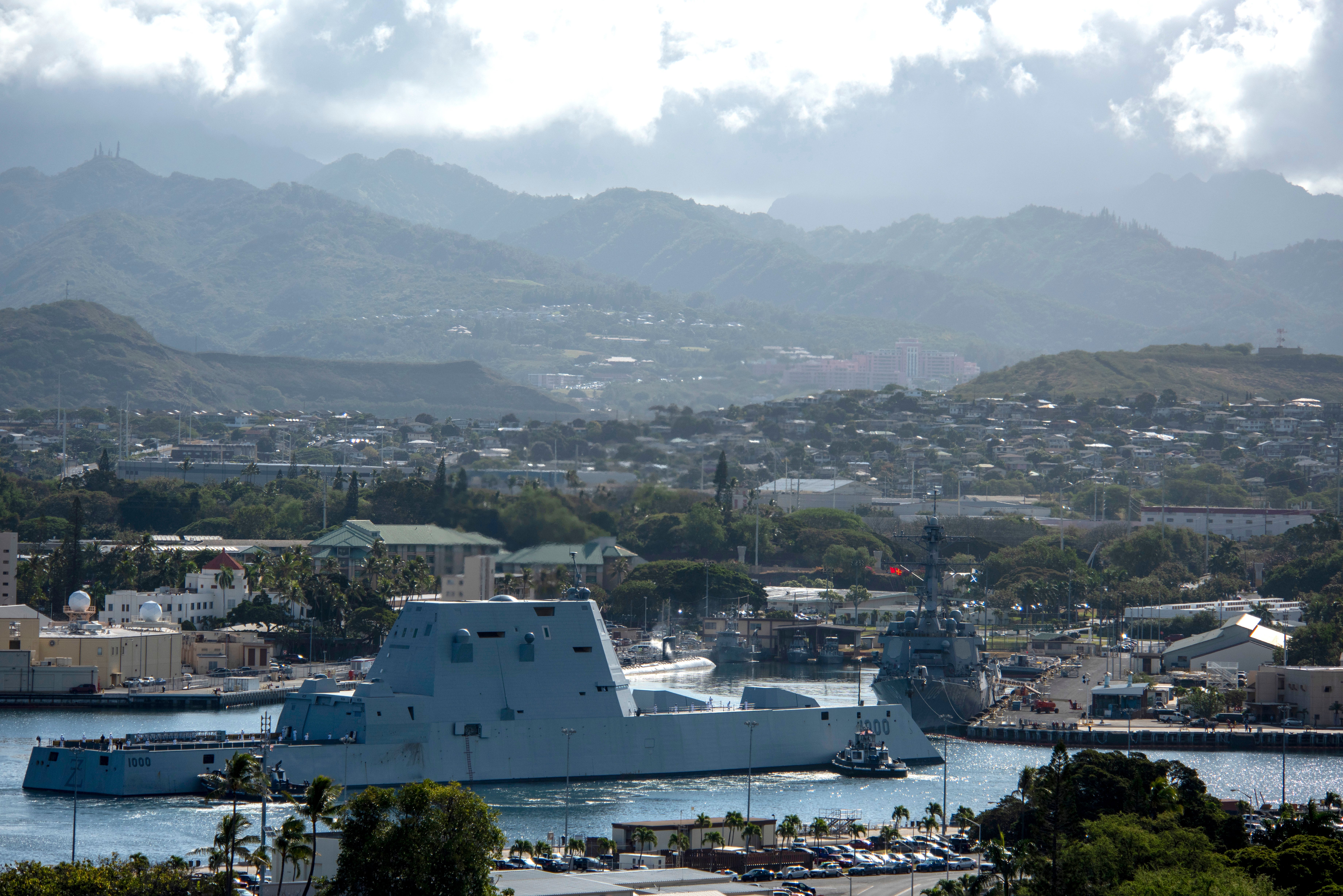
The Navy is standing up an organization today that will be dedicated to experimenting with new unmanned vessels, weapons and other gear to propel the surface force forward.
The service will take the Zumwalt Squadron 1 organization – previously stood up as the man, train and equip organization for the three Zumwalt-class destroyers (DDG-1000) in the fleet – and convert it to the Surface Development Squadron 1.
SURFDEVRON will focus its early efforts on experimenting with the rather unique Zumwalt DDGs – which were converted to blue water strike assets after a long-range land-attack munition for its new gun became too costly and was abandoned – and learning how to leverage the ship’s all-electric Integrated Power System and other features. The SURFDEVRON will also take in the first Sea Hunter medium displacement unmanned surface vehicle (USV) platform in the near term, as well as the second Sea Hunter platform when it finishes construction around the end of Fiscal Year 2020.
As the Medium and Large USV programs begin to deliver vessels to the fleet, SURFDEVRON will incorporate those too, pairing the Zumwalt DDGs and USVs to learn how to pack the most offensive punch with this combination.
“Without getting into classified discussions, I think that we can do a pretty good job imagining how unmanned could support the Zumwalt-class destroyer in its strike mission. So I think that there’s a natural marriage between the Zumwalt-class destroyer and the capabilities that we think unmanned is going to bring to the fleet,” Vice Adm. Richard Brown, commander of Naval Surface Forces and Naval Surface Force Pacific, told reporters this week ahead of today’s SURFDEVRON standup ceremony.
Once MUSVs and LUSVs are available to accompany deployed ships or strike groups, or to be employed by fleet commanders ashore, Brown said, “the possibilities are endless. And so to figure out, flesh out what those possibilities are, we really believe we need an organization that is dedicated to doing that. And that’s the purpose behind the SURFDEVRON.”
Today’s ceremony will take the ZRON-1 organization, led by Capt. Scott Carroll, and replace it – essentially in name only, for now – with the SURFDEVRON led by Capt. Hank Adams, who previously commanded Destroyer Squadron 21.

Brown described the standup of SURFDEVRON as having three phases. Today, the name of the organization will change, and by the fall a new missions, tasks and functions document will be signed by U.S. Pacific Fleet. For now, the squadron will focus on the man, train and equip mission for the Zumwalt class. Currently, only USS Zumwalt (DDG-1000) would reside with the squadron, as USS Michael Monsoor (DDG-1001) was commissioned earlier this year but still must complete its combat system activation – part of a two-phased delivery of the complex ship – and the future Lyndon B. Johnson (DDG-1002) is still being built at General Dynamics Bath Iron Works in Maine.
In Phase 2, spanning from FY 2020 through 2023, three Zumwalt destroyers and two Sea Hunter USVs will begin experimentation as the squadron increases its manpower.
In Phase 3, beginning in FY 2024, MUSVs and LUSVs will begin delivering in numbers, if current budget projections hold true, and the SURFDEVRON will be fully ready to tackle its mission of integrating unmanned surface vessels. Additionally, during this phase the first four Littoral Combat Ships, which had been designated as test assets rather than deployable ships under the current LCS Squadron construct, would be moved into SURFDEVRON. This move would eliminate any daylight between what other surface ships are doing with medium and large USVs and what the LCSs are doing with small USVs.
“We believe that’s the natural progression of the four LCS test ships, transfer from LCSRON over to the SURFDEVRON. And then all that experimentation exists under one commander, and we’re able to just deliver anything that we experiment with or develop for LCS, we do that with SURFDEVRON and then just deliver it over to the LCSRON,” Brown said.

Once the SURFDEVRON is up and running, its experimentation won’t be limited to just unmanned systems.
“Really the whole purpose of the SURFDEVRON is to integrate technical, tactical and material solutions at an accelerated rate,” Brown said.
“And as new capabilities are coming online, whether it’s directed energy weapons or high-energy lasers or hypersonic missiles, we need to rapidly be able to experiment and get these new systems out on ships or platforms, develop the new TTPs (tactics, techniques and procedures) and experiment and move at a faster pace than we have probably moved in the past.”
With Brown, as SURFOR commander, also overseeing the Naval Surface and Mine Warfighting Development Center that owns surface TTPs, Brown said he and his successors would be perfectly positioned to ensure that lessons learned from experiments make it into fleet training and practices, and that any ideas SMWDC comes across are brought to the SURFDEVRON for further work.

As for the Zumwalt destroyers, they will continue with plans to operate as part of a carrier strike group eventually. Under the Optimized Fleet Response Plan, they will go through training and then deploy with the rest of the assigned strike group, but during the sustainment phase – when the CSG would be maintaining its peak readiness at home and being on call for tasking as needed – the DDG-1000s would peel off and conduct experiments instead.
“It is such a unique and capable class of ship. We want to be able to quickly experiment with it,” Brown said.
“So the Zumwalt class will be assigned to a carrier strike group, they will do the whole basic, advanced phase of training, integrated training, go deploy, they’ll be in the same under the OFRP, much like a cruiser or destroyer – but the capability that those ships bring is so unique that we really believe they belong in the SURFDEVRON so we can continually and rapidly experiment with them when they’re not on deployment.”





